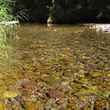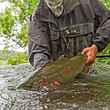Conservation groups are hailing yesterday's House passage of the National Resources Management Act (NRMA), which passed the Senate in a vote roughly two weeks ago, as a historic, bipartisan achievement protecting public lands and wilderness throughout the United States. The NRMA now awaits only signature by Donald Trump.
The NRMA's primary achievement is the permanent re-authorization of the oft-embattled Land and Water Conservation Fund (LWCF), which is likely the nation's most successful and beloved conservation program. Funded almost exclusively by royalties levied on offshore drilling in U.S. public waters, the LWCF has funded over 40,000 conservation projects while essentially costing taxpayers nothing. Since its establishment a half century ago, the LWCF has provided billions of dollars of revenue to communities in all 50 U.S. states while funding both big ambitious projects, like land acquisitions for the establishment of wilderness areas and wildlife refuges, and smaller projects, like the construction of county parks and ballfields.
The LWCF, despite its success, has been a frequent target of political skirmishes and grandstanding and was left to expire in September of last year. Subsequent efforts to re-authorize the LWCF before the end of the last Congress were blocked by anti-public lands senators Rand Paul (R-KY) and Mike Lee (R-UT).
The NRMA's permanent reauthorization of the LWCF specifies a 40/40/20 percent split of the program's funding between federal, state and local, and special programs and requires that 3 percent of the LWCF's total funding be dedicated to enhancing recreational access for anglers and hunters.
But the NRMA's accomplishments reach far beyond reauthorization of the LWCF, protecting hundreds of thousands of acres of wilderness, protecting iconic rivers, removing the threat of mining in sensitive watersheds and more. Among the bill's many accomplishments, the NRMA includes
- Establishment of the Frank and Jeanne Moore Wild Steelhead Special Management Area, protecting approximately 100,000 acres on Steamboat Creek, a vital spawning tributary of the North Umpqua River used by wild steelhead and salmon
- Methow Headwaters Protection Act, which excludes 340,000 acres of U.S. Forest Service land in the Upper Methow Valley off limits from mining, protecting crucial coldwater habitat for rainbow trout, cutthroat trout, bull trout, mountain whitefish, Chinook salmon, and steelhead
- Prevention of mining on the doorstep to Yellowstone National Park via the Yellowstone Gateway Protection Act, helping to protect the imperiled Yellowstone Cutthroat Trout, and headwater streams that feed the Yellowstone River
- The California Desert Protection and Recreation Act which enhances protection on 76 miles of streams, including on of the rare, remaining wild trout streams in southern California
- Establishment of the Cerro del Yuta and Rio San Antonio wilderness areas
- The Yakima River Basin Water Enhancement Act which includes federal authorizations needed to advance the Yakima Basin Integrated Plan—a plan agreed upon by a diverse coalition of conservation groups, irrigators, farmers, sportsmen and women, local, state, and federal governments and the Confederated Tribes and Bands of the Yakima Nation—which aims to restore hundreds of thousands of salmon and steelhead to the basin, improve water quality and quantity, and support in tandem both vibrant agricultural and recreational economies
- Reauthorization of the U.S. Fish and Wildlife Service's Partners for Fish and Wildlife program through 2022
- Reauthorization of and increased funding for the Neotropical Migratory Bird Conservation Act at $6.5 million until 2022
- Authorization for hunters with archery equipment to cross National Park Service lands by foot or horseback
"The good that has been done with today's vote will reach communities across the country. Where do we even start?" said Chris Wood, President and CEO of Trout Unlimited. "A decade's old program to provide access to hunters and anglers has been restored with re-authorization of LWCF. A World War II hero's beloved steelhead river in Oregon is now protected with the Frank and Jeanne Moore bill. In Washington State and in Montana hundreds of thousands of pristine acres are now safeguarded from the threat of irresponsible mining. For all those who love these places, who worry about what will become of them, your moment of peace that comes with protection is almost here. Today is truly a day for a sportsman's heart to feel full."
Though the bill has been widely applauded by conservation groups of all stripes—including groups like Trout Unlimited, Backcountry Hunters & Anglers, Ducks Unlimited, Sierra Club, NRDC, NWF and the Wilderness Society—it has also failed to escape criticism.
While the NRMA permanently reauthorizes the LWCF, critics are quick to point out that it fails to address what has historically been LWCF's primary challenge—lack of funding. Since its establishment in 1964, the LWCF has regularly had its budget raided by Congress, hampering the program's ability to achieve conservation goals. Only once in over 50 years has the LWCF been fully funded. But despite the NRMA permanently re-authorizing the LWCF, it does nothing to address permanently providing full funding for the program.
The bill has also faced sharp criticism for a provision added by Sen. Lisa Murkoswki (R-AK), the bill's sponsor and one of the NRMA's chief advocates, and Sen. Dan Sullivan (R-AK). That provision, the Alaska Native Veterans Land Allotment Equity Act, allows Native Alaskan Vietnam war veterans who missed a historic 1971 homesteader land allotment to claim 160 acres of federal public lands. Detractors allege that the wrong the provision seeks to address has already been righted by Congress, in both 1998 and 2000, and that the act allows these veterans to claim acreage anywhere in the state and subsequently sell that land to private interests—characterizing the provision as little more than a veiled attempt to transfer hundreds of thousands of acres of Alaskan wilderness into the hands of private developers and resource extractors.
Even critics of the lack of full LWCF funding and the inclusion of the Alaska Native Veterans Land Allotment Equity Act, however, acknowledge the sweeping accomplishments of the bill and virtually all have encouraged Donald Trump to take the final step of signing the bill into law.
UPDATE (03-21-2019): Donald Trump signed the NRMA, formally renamed the John D. Dingell Jr. Conservation, Management, and Recreation Act, into law on March 12, 2019, receiving praise from both Democrats and Republicans that supported the bill, as well as a large number of conservation and environmentalist groups.































Comments